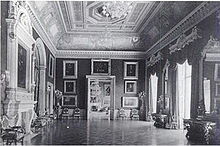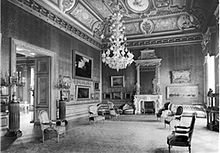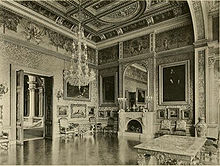Dorchester House
Former mansion designed 1853 by Lewis Vulliamy for Robert Stayner Holford From Wikipedia, the free encyclopedia
Former mansion designed 1853 by Lewis Vulliamy for Robert Stayner Holford From Wikipedia, the free encyclopedia
Dorchester House was a mansion in Park Lane, Westminster, London, which had many different forms over time. The last version used as a private residence was that built in 1853 by Robert Stayner Holford. It was demolished in 1929 to make way for the present Dorchester Hotel.

The site was originally part of the Manor of Hyde, which was given to William the Conqueror by Geoffrey de Mandeville. Joseph Damer acquired it in the 18th century and a large building was constructed in 1751. It was named Dorchester House in 1792 after Damer became the Earl of Dorchester. In the early 19th century it became known as Hertford House after it was purchased by Francis Seymour-Conway, 3rd Marquess of Hertford, and alterations were made to it. Hertford's other London townhouse was Manchester House in Manchester Square, later named Hertford House, now the home of the Wallace Collection. Following the death of Hertford, it was rebuilt by Captain Robert Stayner Holford.
Lewis Vulliamy, who was a notable architect of that time, was instructed to build a house in which a central staircase was a major feature.[1] The main purpose of the building was to house the extensive collection of paintings that Holford had acquired over many years and at that time were temporarily lodged in a friend's residence in Russell Square.[2] Vulliamy's assistant in this project was Jacob Wrey Mould. The 19th-century architecture critic Clarence Cook attributes the grand staircase specifically to Mould, who undertook that task while Vulliamy was incapacitated.[3] Mould subsequently went on to work with Calvert Vaux on many of the initial buildings and design details of New York's Central Park, very notably, Bethesda Terrace.[3]
A description of the house was provided by a publication of that time.

Dorchester House was one of the more palatial buildings in London at the turn of the twentieth century and was frequently mentioned in publications of the time. The staircase (see picture at right) was a notable feature that received much praise. Guy Cadogan Rothery in his book Staircases and Garden Steps said.
The Magazine of Art described it in the following terms.
The magazine illustrated its description of the staircase with a very detailed drawing (see picture left).


One of the most celebrated inclusions in Dorchester House was the chimneypiece in the dining room sculptured by Alfred Stevens (see picture at right). It was regarded as one of his finest works. The Magazine of Art in 1883 contained the following comment.
Rothery made similar laudatory expressions.
The two figures referred to are shown below.
Even though Stevens was credited with the work, he did not complete it before his death in 1875. The picture below, taken by the Magazine "British Architect" shortly after Stevens' death, shows the incomplete chimneypiece. The Victoria and Albert Museum now have the chimneypiece (picture shown below), and according to them it was finished later by Steven's former pupil, James Gamble.[8]

The library was an important room of the house and was specially designed to house Holford's large book collection (see picture right). Morris describes it in the following terms.
Three other rooms in the house were designed to accommodate Holford's famous art collection. The Grand Saloon (see picture below, left) was frequently mentioned in period publications. It was described by one as "a well-proportioned room. The walls covered with red damask and devoted to pictures. The ceiling a good piece of work of its kind was designed by Mr G. E Fox and executed by Mr Alfred Morgan."[10] The other two rooms. known as the green and red drawing rooms (see pictures below), were described by the same author as follows.
 |
 |
 |
| The grand saloon of Dorchester House | The green drawing room of Dorchester House |
The red drawing room of Dorchester House showing the frieze by Sir Coutts Lindsay |

Robert Holford died in 1892 and his son, Sir George Holford, inherited Dorchester House. George did not often occupy the house so in 1905 he rented it to Whitelaw Reid, the American Ambassador. Reid held lavish functions as part of his duties, many of which were mentioned in the newspapers. Of particular note were the Fourth of July celebrations. The New York Times gave the following details of this function held by the Reids at Dorchester House in 1907.
In the same year Reid hosted a function for Mark Twain. The Chancellor of Oxford University wished to confer an honorary degree of Doctor of Letters upon Twain and asked Reid to convey this invitation. Twain accepted and a few days before the Oxford ceremony a dinner was held at Dorchester House for him. Reid invited about forty authors and artists to meet Twain, one of whom was Sir Arthur Conan Doyle.[13]

In 1908 the Reids' daughter Jean was married and the reception was held at Dorchester House. The wedding received a great deal of publicity because King Edward and Queen Alexandra attended. One newspaper commented.
Another newspaper said.
In 1910 after the death of King Edward VII, former President Theodore Roosevelt came to London to attend the funeral. He stayed at Dorchester House for three weeks.[16] The New York Times outlines the numerous visits from dignitaries from other countries that came to Dorchester house to see Roosevelt during this time.
In 1912 Whitelaw Reid died and Dorchester House was no longer used as the American Embassy. Holford used it for occasional parties and to house his orchid collection.
During World War I many of the stately homes of England became Auxiliary Home Hospitals[18] Dorchester House was also offered as a hospital by George Holford. The New York Times in 1914 contained a story about the House as a hospital.
In 1926 Sir George Holford died. His heir was Edmund Parker, 4th Earl of Morley (1877–1951), whose mother was Margaret Holford (1855–1908), daughter of Robert Stayner Holford. The Earl was at that time in a very poor financial condition, having inherited large debts from his father and grandfather, and immediately put up for sale his Holford inheritance of both Dorchester House and Westonbirt House in Gloucestershire, although he retained the arboretum of the latter.[20] After three years an acceptable offer was received and Dorchester House was sold. The following article was published in The Times on 16 July 1929:
Dorchester House was duly demolished in 1929 and the new Dorchester Hotel opened in 1931.
Seamless Wikipedia browsing. On steroids.
Every time you click a link to Wikipedia, Wiktionary or Wikiquote in your browser's search results, it will show the modern Wikiwand interface.
Wikiwand extension is a five stars, simple, with minimum permission required to keep your browsing private, safe and transparent.